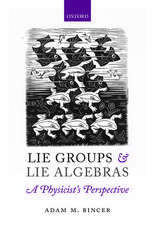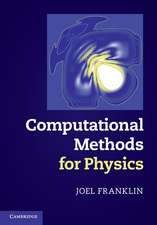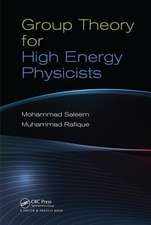Essays on Supersymmetry: Mathematical Physics Studies, cartea 8
Editat de C. Fronsdal, M. Flato, T. Hiraien Limba Engleză Paperback – oct 2011
Din seria Mathematical Physics Studies
- 18%
 Preț: 735.38 lei
Preț: 735.38 lei -
 Preț: 459.53 lei
Preț: 459.53 lei - 18%
 Preț: 887.05 lei
Preț: 887.05 lei - 15%
 Preț: 528.95 lei
Preț: 528.95 lei - 15%
 Preț: 523.91 lei
Preț: 523.91 lei - 18%
 Preț: 721.63 lei
Preț: 721.63 lei - 15%
 Preț: 637.28 lei
Preț: 637.28 lei - 18%
 Preț: 1004.99 lei
Preț: 1004.99 lei - 15%
 Preț: 641.53 lei
Preț: 641.53 lei - 18%
 Preț: 722.26 lei
Preț: 722.26 lei - 18%
 Preț: 890.85 lei
Preț: 890.85 lei -
 Preț: 392.21 lei
Preț: 392.21 lei - 18%
 Preț: 956.50 lei
Preț: 956.50 lei - 15%
 Preț: 579.52 lei
Preț: 579.52 lei -
 Preț: 403.15 lei
Preț: 403.15 lei - 18%
 Preț: 902.78 lei
Preț: 902.78 lei - 18%
 Preț: 735.07 lei
Preț: 735.07 lei - 18%
 Preț: 886.26 lei
Preț: 886.26 lei -
 Preț: 416.61 lei
Preț: 416.61 lei - 24%
 Preț: 740.68 lei
Preț: 740.68 lei - 18%
 Preț: 893.84 lei
Preț: 893.84 lei - 18%
 Preț: 726.85 lei
Preț: 726.85 lei - 18%
 Preț: 785.86 lei
Preț: 785.86 lei - 18%
 Preț: 740.91 lei
Preț: 740.91 lei - 15%
 Preț: 661.02 lei
Preț: 661.02 lei - 15%
 Preț: 586.88 lei
Preț: 586.88 lei -
 Preț: 354.21 lei
Preț: 354.21 lei - 18%
 Preț: 946.10 lei
Preț: 946.10 lei - 24%
 Preț: 1016.52 lei
Preț: 1016.52 lei -
 Preț: 394.87 lei
Preț: 394.87 lei -
 Preț: 387.58 lei
Preț: 387.58 lei - 18%
 Preț: 950.52 lei
Preț: 950.52 lei
Preț: 387.58 lei
Nou
Puncte Express: 581
Preț estimativ în valută:
74.17€ • 79.31$ • 61.84£
74.17€ • 79.31$ • 61.84£
Carte tipărită la comandă
Livrare economică 18 aprilie-02 mai
Preluare comenzi: 021 569.72.76
Specificații
ISBN-13: 9789401085557
ISBN-10: 9401085552
Pagini: 284
Ilustrații: 280 p.
Dimensiuni: 155 x 235 x 15 mm
Greutate: 0.4 kg
Ediția:Softcover reprint of the original 1st ed. 1986
Editura: SPRINGER NETHERLANDS
Colecția Springer
Seria Mathematical Physics Studies
Locul publicării:Dordrecht, Netherlands
ISBN-10: 9401085552
Pagini: 284
Ilustrații: 280 p.
Dimensiuni: 155 x 235 x 15 mm
Greutate: 0.4 kg
Ediția:Softcover reprint of the original 1st ed. 1986
Editura: SPRINGER NETHERLANDS
Colecția Springer
Seria Mathematical Physics Studies
Locul publicării:Dordrecht, Netherlands
Public țintă
ResearchCuprins
1. Why supersymmetry?.- 2. Why in de Sitter space?.- 3. Why group theory?.- 4. Background.- 5. This book, summary.- 6. Future directions.- Unitary Representations of Supergroups.- 0. Introduction..- 1. General structural problems.- 2. Invariant Hermitean forms.- 3. An example: osp(2n/l).- 3+2 De Sitter Superfields.- 0. Introduction.- 1. Superfields and induced representations.- 2. Induction from an irreducible representation.- 3. Invariant operators.- 4. Massive superfields, “scalar” multiplet.- 5. The “vector” multiplet.- 6. The simplest superfield for N = 2 supersymmetry.- 7. Induction from an irreducible representation.- 8. Wave equations for N = 2.- 9. The spinor superfield and de Sitter chirality.- Appendices.- Al. Linear action for osp(2n/l).- A2. Linear action for osp(2n/2).- A3. Intertwining operators.- A4. Invariant fields.- Spontaneously Generated Field Theories, Zero-Center Modules, Colored Singletons and the Virtues of N = 6 Supergravity.- 0. Introduction.- 1. De Sitter electrodynamics.- 2. Conformal electrodynamics.- 3. De Sitter super electrodynamics.- 4. Extended de Sitter super electrodynamics.- 5. Super conformal electrodynamics.- 6. Extended super conformal electrodynamics.- Massless Particles, Orthosymplectic Symmetry and Another Type of Kaluza-Klein Theory.- 0. Introduction.- I. Geometric preliminaries.- II. Superfield preliminaries.- III. Algebraic representation theory.- IV. Homogeneous space and line bundle.- V. Physical interpretation.- VI. Scalar field on space time.- VII. osp(8) field theory--a beginning.















